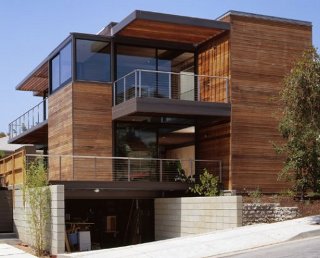Construction
LEED Certification
Certification of a Building

The first Platinum rated LEED home (Santa Monica, CA)
“LEED certified projects blend environmental, economic, and occupant-oriented performance. They cost less to operate and maintain; are energy- and water-efficient; have higher lease- up rates than conventional buildings in their markets; are healthier and safer for occupants; and are a physical demonstration of the values of the organizations that own and occupy them.“[1]
It’s important to understand the difference between Certified and Accredited. A building can become LEED Certified, while a person can become a LEED AP? – or an Accredited Professional. Confusing the two is a dead giveaway for someone who is just jumping on the “green” bandwagon.
There are several versions of Certification a project can choose to follow depending on the type of construction. These include:
- LEED NC: New construction and major renovations (this version is covered here, as it is most common)
- LEED EB: Existing buildings all fall under this category; existing means occupied
- LEED CI: Commercial interior furnishing by tenants
- LEED for Core and Shell: Projects with future tenants
- LEED for Homes
- LEED for Schools
- LEED for Retail: Coming soon
- LEED for Neighborhood Development: Coming soon
Project Registration
Registering a project early on in the process is extremely important; it solidifies the commitment for the designers to follow suit. This is a common thread throughout the LEED AP Exam: earlier is optimal. The exam covers Project Administration, and some important things to remember about registration are: register early, register online (save the trees, remember?), payment is based on square footage and whether or not a member of the USGBC signed up the project.
LEED Online
“Online” is another common theme of the exam. All major milestones for LEED Certification are completed online. This includes, and is not limited to, registration, submittals, CIRs, delegation of responsibility for certain credits, calculations for credits, and all updates throughout the project. Be sure to browse the USGBC’s website before taking the exam, as all online information is fair game to be included in the exam.
Credit Interpretation Rulings
CIRs are another integral part of required knowledge for the exam. They are basically RFI’s (request for information) submitted to the USGBC to see if an alternative application of a credit can apply. These are important for a project well into the design phase that is looking to fulfill a credit in a way that is not specifically detailed in the LEED Reference Manual.
LEED Online Submittals
So how does a project get points towards certification? Each of the credits listed on the LEED Scorecard requires a submittal to the USGBC to score a point towards certification. If you’re familiar with the construction process, this is just like a submittal you would provide to an owner for a product in the specifications.
Rating System for Buildings
There are several levels of certification a building can acquire: Certified, Silver, Gold and Platinum. In its fledgling years, the USGBC also had another category: Bronze, but it has since been put to rest, as the award did not require exceptional measures to gain certification. Each level of certification is defined by the number of points the project has both submitted for and been awarded. For LEED 2.2 and earlier, the project certification was based on a scale of 1 – 64. Click the link above to compare the old rating system to the new LEED 3.0
Note: As of February 2009, the highest score received on a Platinum project is 64 points. See the photo on the LEED main page of the Dockside Green in British Colombia.
References:
- The USGBC’s website:
